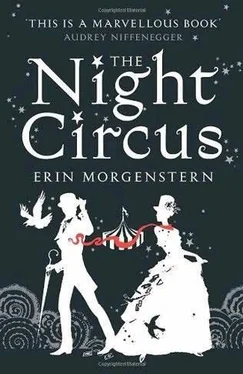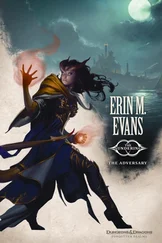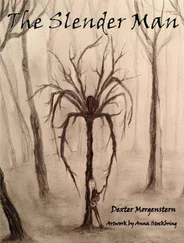The contortionist lifts a small silver metal hoop from the ground, brandishing it with a few simple but impressive movements. She passes it to a man in the front of the crowd, in order to establish that it is solid. When he hands it back to her, she passes her entire body through it, extending her limbs in fluid, dance-like motions.
After discarding the hoop, she places a small box in the center of the platform.
The box looks no more than a foot wide or high, though in reality it is slightly larger than that. While the act of a fully grown (if below-average-size) woman condensing herself into such a confined space would be impressive regardless of the details of the box, it is made even more impressive in this case by the fact that this box is made of glass, completely transparent.
The edges are metal, oxidized to a blackish tinge, but the side panels and the lid are clear glass, so she is visible the entire time as she bends and twists and folds herself into the tiny space. She does it slowly, making each minute movement part of the show, until her body and head are completely within the box and only her hand remains without, sticking out the top. The view from Bailey’s perspective looks impossible, a bit of leg here, the curve of a shoulder there, part of her other arm underneath a foot.
Only one hand remains, it waves cheerfully before pulling the lid closed. It latches automatically, and the box is undeniably closed, with the contortionist clearly visible inside.
And then the glass box with the woman trapped inside slowly fills with white smoke. It curls through the tiny cracks and spaces not occupied by limbs or torso, and seeps between her fingers as they press against the glass.
The smoke thickens, obscuring the contortionist completely. There is only white smoke visible inside the box, and it continues to ripple and undulate against the glass.
Suddenly, with a popping noise, the box breaks. The glass panels fall to the sides and the lid collapses downward. Curls of smoke rise into the night air. The box, or, rather, the small pile of glass upon the platform that had once been a box, is empty. The contortionist is gone.
The crowd waits for several moments, but nothing happens. The last wisps of smoke dissipate, the crowd begins to disperse.
Bailey takes a closer look as he walks by, wondering if the contortionist is somehow concealed in the platform, but it is solid wood and open underneath. She has vanished completely despite the plain evidence that there was nowhere for her to go.
Bailey continues down the winding path. He finishes his cider and finds a bin to discard his cup, though as soon as he places it within the shadowed container it seems to vanish.
He walks on, reading signs, trying to decide which tent to enter. Some are large and decorated with flourishes and long descriptions of their contents.
But the one that catches his eye is smaller, as is the tent on which it hangs. Looping white letters on a black background.
Feats of Illustrious Illusion
The entrance is open, and a line of patrons files into the illusionist’s tent. Bailey joins them.
Inside it is lit by a line of black iron sconces along the rounded wall and contains nothing but a ring of plain wooden chairs. There are only about twenty of them, in two staggered rows so that the view from each seat is comparable. Bailey chooses a seat in the inside row, across from the entrance.
The rest of the seats fill quickly, save for two: the one to his immediate left and another across the circle.
Bailey notices two things at once.
First, that he can no longer see where the entrance had been. The space where the audience had entered now appears to be solid wall, seamlessly blending with the rest of the tent.
Second, there is now a dark-haired woman in a black coat sitting to his left. He is certain that she was not there before the door disappeared.
Then his attention is removed from both these events as the empty chair across the circle bursts into flame.
The panic is instant. Those occupying the chairs closest to the flaming chair abandon their seats and rush for the door, only to find that there is no longer a door to be found, only a solid wall.
The flames grow steadily higher, staying close to the chair, licking around the wood, though it does not appear to be burning.
Bailey looks again at the woman to his left, and she winks at him before standing and walking to the center of the circle. Amidst the panic, she calmly unbuttons her coat and removes it, tossing it with a delicate gesture toward the burning chair.
What had been a heavy wool coat becomes a long piece of black silk that ripples like water over the chair. The flames vanish. Only a few lingering wisps of smoke remain, along with the sharp smell of charred wood that is slowly changing to the comforting scent of a fireplace, tinged with something like cinnamon or clove.
The woman, standing in the center of the circle of chairs, pulls back the black silk with a flourish, revealing a still-intact chair on which now perch several snow-white doves.
Another flourish, and the black silk folds and curves in on itself, becoming a black top hat. The woman places it on her head, topping off an ensemble that looks like a ball gown fashioned out of the night sky: black silk dotted with sparkling white crystals. She acknowledges her audience with a subtle bow.
The illusionist has made her entrance.
A few people, including Bailey, manage to applaud, while those who had abandoned their seats return to them, looking both disturbed and curious.
The performance is continuous. The displays Bailey has difficulty thinking of as tricks meld one into the other. The doves vanish frequently, only to reappear on hats or under chairs. There is also a black raven, far too large to have been cleverly concealed. It is only after the performance has gone on for some time that Bailey slowly realizes that because of the circle of chairs, the shape and closeness of the space, there is no room for mirrors or tricks of the light. Everything is immediate and palpable. She even transforms one audience member’s pocket watch from metal to sand and back again. At one point all the chairs float some distance off the ground, and while the movement is steady and secure, Bailey’s toes barely graze the floor and he clutches the sides of his chair nervously.
At the end of the act, the illusionist takes a bow with a pivoting turn, acknowledging the entire circle as the audience applauds. As she completes the rotation, she is no longer there. Only a few sparkling shimmers remain, echoes of the crystals in her gown.
The door reappears in the side of the tent and the small audience makes their way out. Bailey lags behind, glancing back as he leaves at the spot where the illusionist had been.
Outside, though it was not there before, is another raised platform, much like the one the contortionist stood on. But the figure on this platform does not move. Bailey almost thinks it is a statue, dressed in a white gown edged in matching fur that cascades beyond the platform to the ground. Her hair and skin, even her eyelashes, are an icy white.
But she moves. Very, very slowly. So slowly that Bailey cannot pinpoint exact motions, only slight changes. Soft flakes of iridescent snow float to the ground, falling from her like leaves from a tree.
Bailey walks around, looking at her from every angle. Her eyes follow him, though the snow-flecked lashes do not blink.
There is a small silver plaque on the platform, partially obscured by the cascading gown.
It reads in memoriam, but it does not specify who it is for.
Rules of the Game: 1887-1889
There are fewer Circus Dinners now that the circus itself is up and running properly, gaining its self-sufficiency, as Chandresh phrased it at one dinner not long after opening night. The original conspirators still gather for dinner occasionally, particularly when the circus is performing nearby, but this has become more and more infrequent.
Читать дальше












